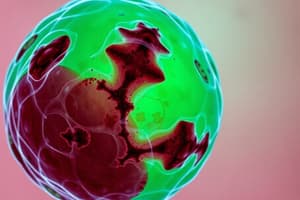Podcast
Questions and Answers
What is the main characteristic of hypertrophy?
What is the main characteristic of hypertrophy?
- Increase in the number of cells
- Increase in the size of existing cells (correct)
- Replacement of one cell type with another
- Shrinkage in cell size
Which of the following describes apotosis?
Which of the following describes apotosis?
- A form of cell injury leading to cell death
- A regulated process leading to cell death (correct)
- The formation of new cells from stem cells
- An adaptive response to injury
What typically triggers pathological hyperplasia?
What typically triggers pathological hyperplasia?
- Invasive infections
- Nutritional imbalances (correct)
- Physical exercise
- Hormonal stimuli
What distinguishes autophagy from other cell injury mechanisms?
What distinguishes autophagy from other cell injury mechanisms?
Which mechanism is responsible for cellular swelling in response to injury?
Which mechanism is responsible for cellular swelling in response to injury?
Which statement about reversible cell injury is true?
Which statement about reversible cell injury is true?
What is the goal of cellular adaptations to injury?
What is the goal of cellular adaptations to injury?
Which condition does NOT typically lead to atrophy?
Which condition does NOT typically lead to atrophy?
Which type of cell death involves the activation of enzymes that degrade the cell's own nuclear DNA and cytoplasmic proteins?
Which type of cell death involves the activation of enzymes that degrade the cell's own nuclear DNA and cytoplasmic proteins?
What is a key feature that differentiates necrosis from apoptosis?
What is a key feature that differentiates necrosis from apoptosis?
Which of the following necrosis types is characterized by the transformation of tissue into a liquid viscous mass?
Which of the following necrosis types is characterized by the transformation of tissue into a liquid viscous mass?
In which condition can a cell potentially reverse from dysplasia back to normal?
In which condition can a cell potentially reverse from dysplasia back to normal?
What happens to cellular contents during apoptosis?
What happens to cellular contents during apoptosis?
What is the potential effect on neighboring cells caused by the remnants of necrotic cells?
What is the potential effect on neighboring cells caused by the remnants of necrotic cells?
Which physiological adaptation is characterized by the replacement of one cell type with another to withstand environmental stress?
Which physiological adaptation is characterized by the replacement of one cell type with another to withstand environmental stress?
What is the role of vATPase at the lysosomal interface during autophagy?
What is the role of vATPase at the lysosomal interface during autophagy?
What type of cellular adaptation results in an increase in the size of cells?
What type of cellular adaptation results in an increase in the size of cells?
What distinguishes physiological adaptation from pathological adaptation?
What distinguishes physiological adaptation from pathological adaptation?
Which of the following best describes the mechanism of apoptosis?
Which of the following best describes the mechanism of apoptosis?
Cell autophagy primarily serves what purpose in cellular health?
Cell autophagy primarily serves what purpose in cellular health?
Which of the following processes is characterized by cellular swelling due to injury?
Which of the following processes is characterized by cellular swelling due to injury?
What is the likely fate of a cell that fails to adapt to increased workload?
What is the likely fate of a cell that fails to adapt to increased workload?
Which of the following statements about necrosis is true?
Which of the following statements about necrosis is true?
Which stimulus is most likely to cause physiological hypertrophy in a cell?
Which stimulus is most likely to cause physiological hypertrophy in a cell?
Flashcards are hidden until you start studying
Study Notes
Cell Injury
- Cell injury can be caused by functional and biochemical abnormalities of essential cellular components.
- Multiple biochemical alterations can be triggered by any one injurious insult.
Cell Death
- Cell death can be characterized by loss of membrane integrity, leakage of cellular contents, and eliciting an inflammatory response.
- Different patterns of necrosis can indicate the underlying cause.
- Coagulative necrosis is characterized by the coagulation of cellular proteins, while liquefactive necrosis is associated with the enzymatic digestion of cells.
- Gangrenous necrosis is a type of coagulative necrosis that occurs in extremities, while caseous necrosis is characterized by a cheese-like appearance and is often associated with tuberculosis.
Apoptosis
- Apoptosis is a programmed cell death pathway, also known as cell suicide.
- In apoptosis, cells activate enzymes that degrade their own DNA and proteins.
- The cell membrane remains intact, but it is altered in a way that triggers phagocytosis.
- This eliminates the cell before cellular contents leak, preventing inflammation.
Necrosis vs. Apoptosis
- Necrosis is a form of cell death that is caused by injury or stress.
- Apoptosis is a form of programmed cell death.
- Feature | Necrosis | Apoptosis
- -- | --- | ---
- Cell Size | Enlarged | Shrunken
- Nucleus | Pyknotic, fragmented, or dissolved | Fragmentation into nucleosome-sized fragments
- Plasma membrane | Disrupted | Intact, altered structure leading to phagocytosis
- Cellular Contents | Enzymatic digestion, leakage | Release of apoptotic bodies
- Adjacent Inflammation | Present | Absent
- Physiologic or Pathologic Role | Pathologic | Physiologic/Pathologic
Autophagy
- Autophagy is a cellular process that involves the degradation of cellular components.
- It involves formation of a double membrane structure called autophagosomes.
- This structure engulfs cellular components for degradation by lysosomes.
- vATPase (vacuolar ATPase) is necessary for lysosomal function in autophagy. Without vATPase, autophagosomes may not be degraded properly and could accumulate within the cell.
Metaplasia and Dysplasia
- Metaplasia is a reversible change in which one adult cell type is replaced by another adult cell type.
- It's a response to stress or injury that allows the cells to become more resistant to the damaging stimulus.
- Metaplasia can occur when stem cells are reprogrammed or when differentiated cells change phenotype.
- Dysplasia is a change in cell growth and differentiation that can precede cancer.
- It's often considered a precancerous lesion.
- Metaplasia can progress to dysplasia if the stress or injury persists.
- Dysplasia is not always reversible and can lead to cancer.
- The point of irreversibility is determined by the severity and duration of the underlying stress or injury.
Hyperplasia
- Hyperplasia is an increase in the number of cells in an organ or tissue.
- It's often caused by hormonal stimulation or increased demand.
- Hyperplasia can be physiological or pathological.
- Physiological hyperplasia is a normal response to stimuli and is essential for growth and development.
- Pathological hyperplasia is an abnormal response to stimuli and can lead to disease.
- Goal of Adaption: To increase the number of functional cells to meet the increased demand, or to replace damaged cells.
Hypertrophy
- Hypertrophy is an increase in the size of cells.
- It occurs when cells cannot divide.
- It's often caused by increased workload or hormonal stimulation.
- Hypertrophy is generally accompanied by an increase in the amount of protein and organelles within the cells.
- Goal of Adaption: To increase the functional capacity of the organ or tissue.
Atrophy
- Atrophy is a decrease in the size of cells.
- It occurs when cells are not stimulated or receive insufficient nutrition.
- It can occur in any cell type, but it is most common in skeletal muscle, heart, and brain.
- Goal of Adaption: To reduce the energy expenditure of a cell to protect itself from further damage.
Overview of Cell Injury
- Cell injury can be reversible or irreversible.
- Reversible cell injury refers to changes in cell function and morphology that are reversible if the stress or injury is removed.
- Irreversible cell injury refers to changes in cell function and morphology that are not reversible, leading to cell death.
Cellular Response to Injury
- The cell's response to injury depends on several factors, including the type of injury, its duration, and severity.
- The consequences of an injurious stimulus depend on the cell's type, status, adaptability, and genetic makeup.
Mechanisms of Cell Injury
- Hypoxia: Oxygen deprivation, a major cause of cell injury, can occur due to ischemia or reduced blood flow.
- Chemical agents: Chemicals can injure cells by interfering with normal cellular function, such as metabolism or energy production.
- Infectious agents: Viruses, bacteria, fungi, and parasites can cause cell injury through a variety of mechanisms, including direct infection, release of toxins, and triggering of inflammatory responses.
- Immunologic reactions: The immune system can also cause cell injury through mechanisms like autoimmune reactions and hypersensitivity reactions.
- Genetic factors: Mutations in genes can lead to defective proteins or enzymes that can cause cell injury.
- Nutritional imbalances: Deficiencies or excesses of nutrients can disrupt normal cellular function, leading to cell injury.
- Physical agents: Physical agents like trauma, extreme temperatures, radiation, and electricity can cause cell injury.
- Aging: The process of aging can lead to cellular senescence and increased vulnerability to injury.
Morphology of Cell Injury
- The morphological changes associated with cell injury can be categorized as cellular swelling and fatty change.
Importance of Practice & Teaching
- Discussing information helps retain 50% of the knowledge.
- Practicing the information helps retain 75% of the knowledge.
- Teaching others the information helps retain 90% of the knowledge.
Learning Objectives
- Understand the different fates of a cell following an injury or stress.
- Comprehend the mechanisms of cell adaptations, including hypertrophy, hyperplasia, atrophy, and metaplasia.
- Distinguish between reversible and irreversible cell injury.
- Explain the mechanistic changes that can lead to cell injury or death.
- Differentiate between apoptosis and necrosis, outlining their mechanisms.
- Describe the mechanism of cell autophagy.
Studying That Suits You
Use AI to generate personalized quizzes and flashcards to suit your learning preferences.




